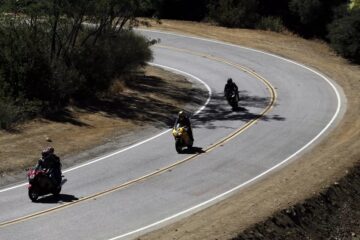Story of the Conejo Valley written in peaks, bluffs and ridges
How an ancient river of magma shaped the Conejo Valley
Source of this article, the Thousand Oaks Acorn, June 22, 2017
As it travels west out of the Conejo Valley, the 101 Freeway works its way down the Conejo Hills in the shadow of Conejo Mountain. At 1,800 feet tall, the peak separating Thousand Oaks from Camarillo is the highest point in the Conejo Hills.
But as formidable as the slope may seem to motorists today, it pales in comparison to its ancient self.
The mountain, and others in the region, was once three times as tall, a discovery made during construction of the Westlake Village Costco in 1996. Earth movers uncovered ancient fossils, including pine cones that could only have grown at an elevation of 8,000 feet.
William Bilodeau, a professor of geology at Cal Lutheran University, where the cones are now kept, said the fossils were an important find.
“It really painted the picture of what the ancient Conejo Valley looked like,” he said. “It was a window into the past.”
Volcanic activity
The discovery was a glimpse into the natural forces behind the Conejo Valley and its sculptural landscape dominated by peaks, bluffs and slopes.
In the southwest corner of the valley, Mount Boney stands at just over 2,800 feet above sea level, but 24 million years ago, the landscape was flat—nothing but sea floor, Bilodeau said.
The movement of tectonic plates changed all that.
As the Pacific Plate started to press against the North American Plate, the tremendous crushing weakened rocks near the surface, allowing a channel of magma to flow from inside the earth onto the ocean floor.
As it cooled under the coastal waves, the lava hardened into distinctive pillow formations, a telltale sign of underwater volcanism.
“The beaches were a little farther east back then and Thousand Oaks had this shoreline. You can see pillow basalt formations along the Backbone Trail in Circle X Ranch,” he said.
Pillow basalts are also visible on Yerba Buena Road.
The molten-hot magma bubbled up for 3 million years, creating multiple volcanoes, some of which rose above sea level before being resubmerged, Bilodeau said.
A cross section of a 17-million year-old volcano found near Kanan and Agoura roads is referred to as the “Bowels of Hades” or “Gates of Hell” because this portion preserves the conduit through which molten rock flowed to the surface.
Volcanic activity ended 15 million years ago, according to research by the National Park Service. Since then, wind and time have reduced Mount Boney and Conejo Mountain to a third of their original size, and only the densest rock—the rock that ultimately clogged the volcanic vent—remains.
“The last eruption plugged its throat,” Bilodeau said. “The rock that plugged the volcano is the mountain we see today.”
The rocks the volcanoes produced, known as the Conejo Volcanics, are unique because they contain limestone embedded with oyster shells and other marine fossils like barnacles, fish scales and wood. Most volcanic rock does not contain fossils.
n some places in the western Santa Monica Mountains, including Boney Ridge and the Conejo Hills, evidence of volcanic activity can still be seen. At 3,114 feet, Sandstone Peak is the highest point in the Santa Monica range.
Despite what its name suggests, Sandstone Peak is made of a type of volcanic igneous rock called andesite.
“From Kanan and west along Boney Ridge is volcanic rock,” Bilodeau said. “But they’re all tilted and folded and deformed since then.”
Rotating mountains
For millions of years after the area’s last volcanic activity, layers of sediment were deposited on top of the dense volcanic rock as tectonic forces pushed Earth’s crust higher.
The resulting mountain range was a rock formation with a north-south orientation. But in the ages that followed, the mountains began to drift until they were oriented east-west, one of only two mountain ranges in North America to do so. (The Uinta Mountains of Utah is the other.)
“It was a time of rotation,” Bilodeau said. “The western Santa Monica Mountains didn’t start to look like they do now until 3 (million) or 4 million years ago.”
As tectonic plate boundaries rotated, they pulled the crust apart, separating Baja California from the mainland and crushing the crust underneath the layers of volcanic and sedimentary rock, creating what we know as the Santa Monica Mountains, he said.
Rocking views
The Conejo Volcanics aren’t the only rocks in town.
Because the Conejo Valley is near the boundary of an active fault system, multiple ancient rock formations have been folded into the local bedrock like marble cake.
Looking at a geologic map of Thousand Oaks, the city is bisected approximately along Moorpark Road, with the western half of the city sitting on Conejo Volcanics and much of the rest on the Monterey Formation, an oil-rich sedimentary rock that is the source of most of California’s known oil.
The Topanga Canyon Formation is much older than the Conejo Volcanics and underlies much of its volcanic material. It is usually light gray, tan or brown sandstone. Composed of marine sedimentary rocks, the Topanga Canyon Formation makes up most of Sycamore Canyon, Wildwood Regional Park and Hidden Valley. It can also be seen in road cuts along Topanga Canyon Boulevard.
“You can see it along PCH, as well,” Bilodeau said.
Anthony Bevilacqua is a park ranger for the National Park Service. He said hikers can enjoy many of the area’s geologic resources from the trail.
“There are some amazing sights out there, no matter what you’re looking for,” he said.
To explore areas of volcanic bedrock, he recommended the hike to Sandstone Peak.
To see fossil remains, Bevilacqua recommended Eagle Rock Trail and Red Rock Canyon in Topanga State Park.
For dramatic wind-and-erosion carved sandstone, the ranger said to try the Castro Crest area next to the Corral Canyon parking lot.
Fossils can also be seen on the Mesa Peak fire road.
Zach Behrens is a communications fellow with the National Park Service. He said park rangers offer tours of natural points of interest. On one such guided hike recently, Behrens said, he discovered his new favorite trail.
He recommends the Backbone Trail between Mishe Mokwa and Encinal Canyon.
“I love going out to the western end to see the volcanics,” he said. “It’s the Sedona of Malibu.”
A geologic survey of the Santa Monica Mountains is available at nps.gov.



0 Comments